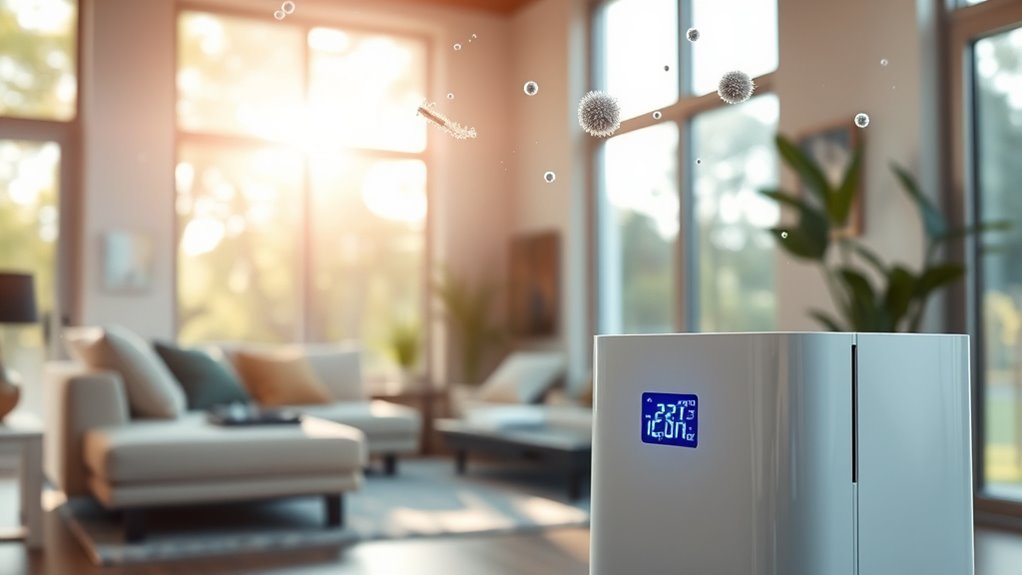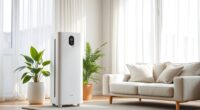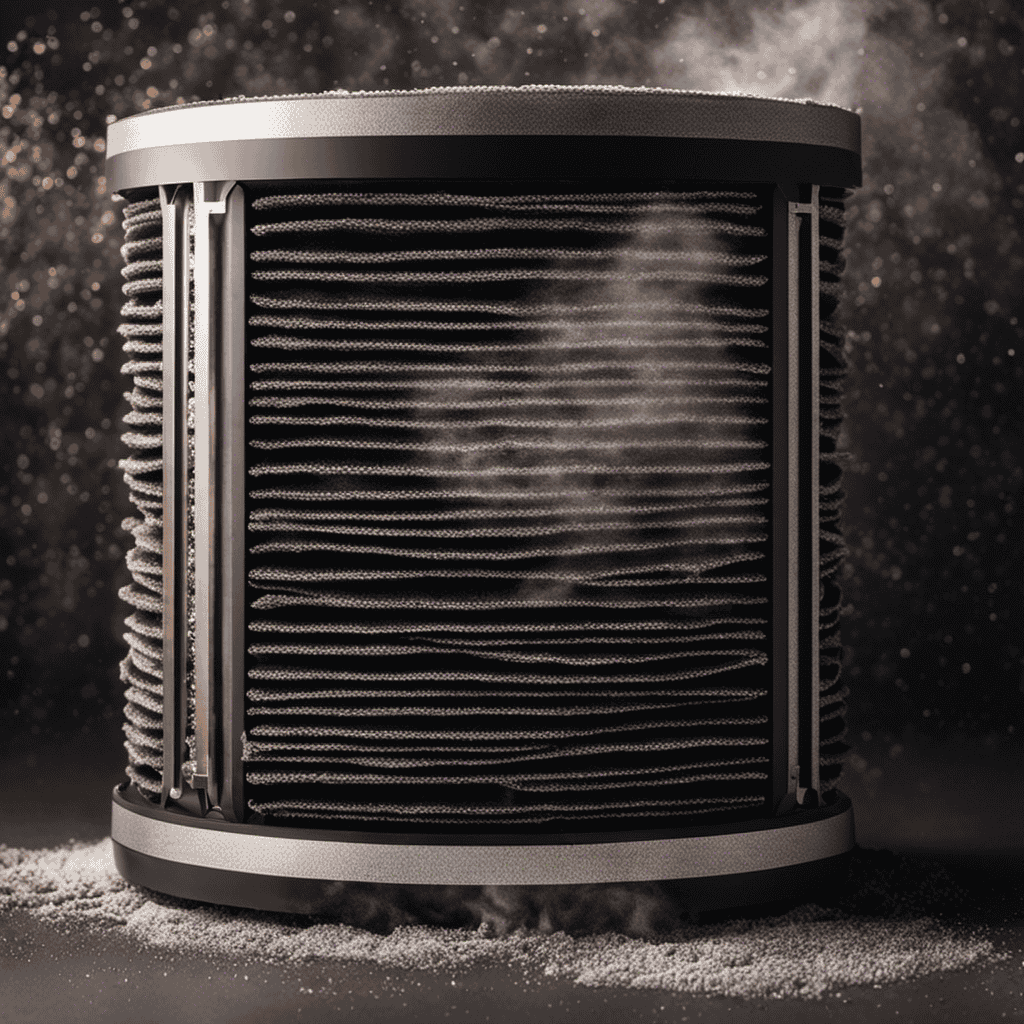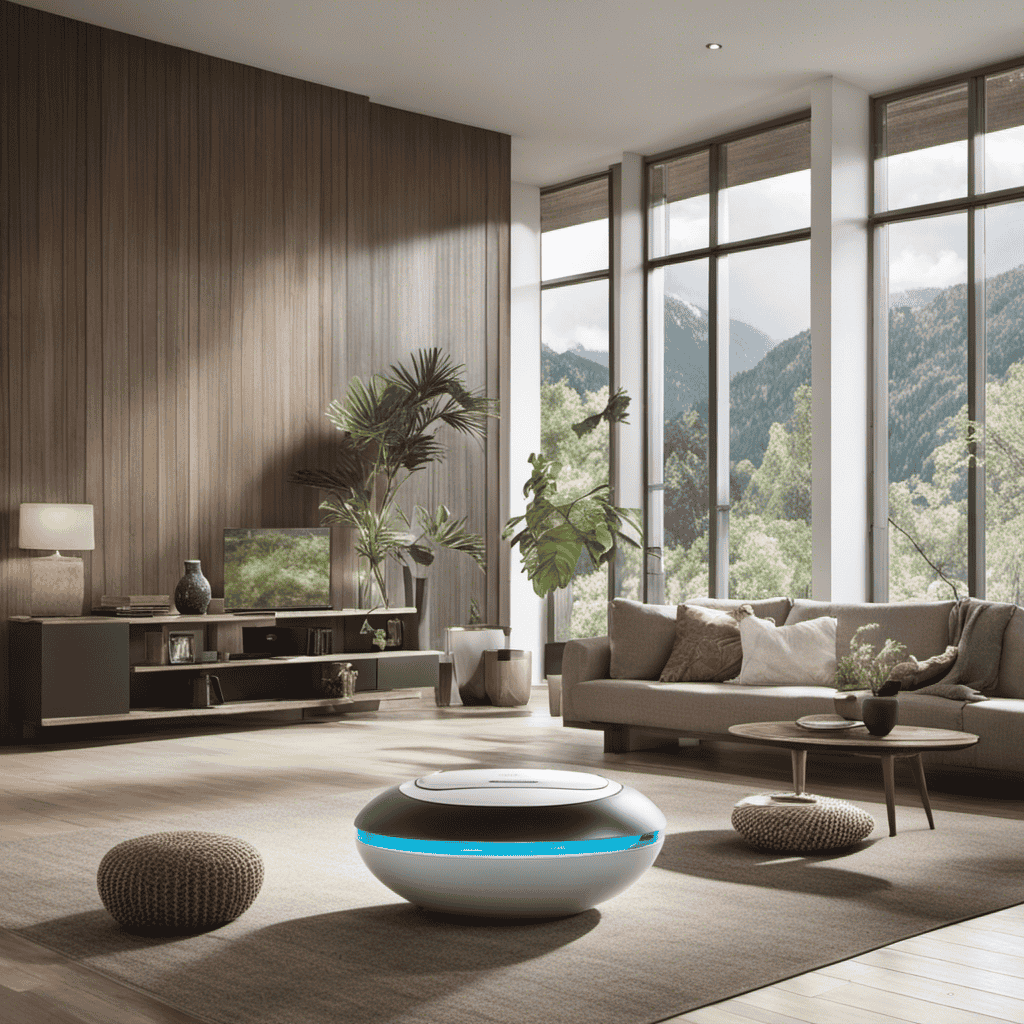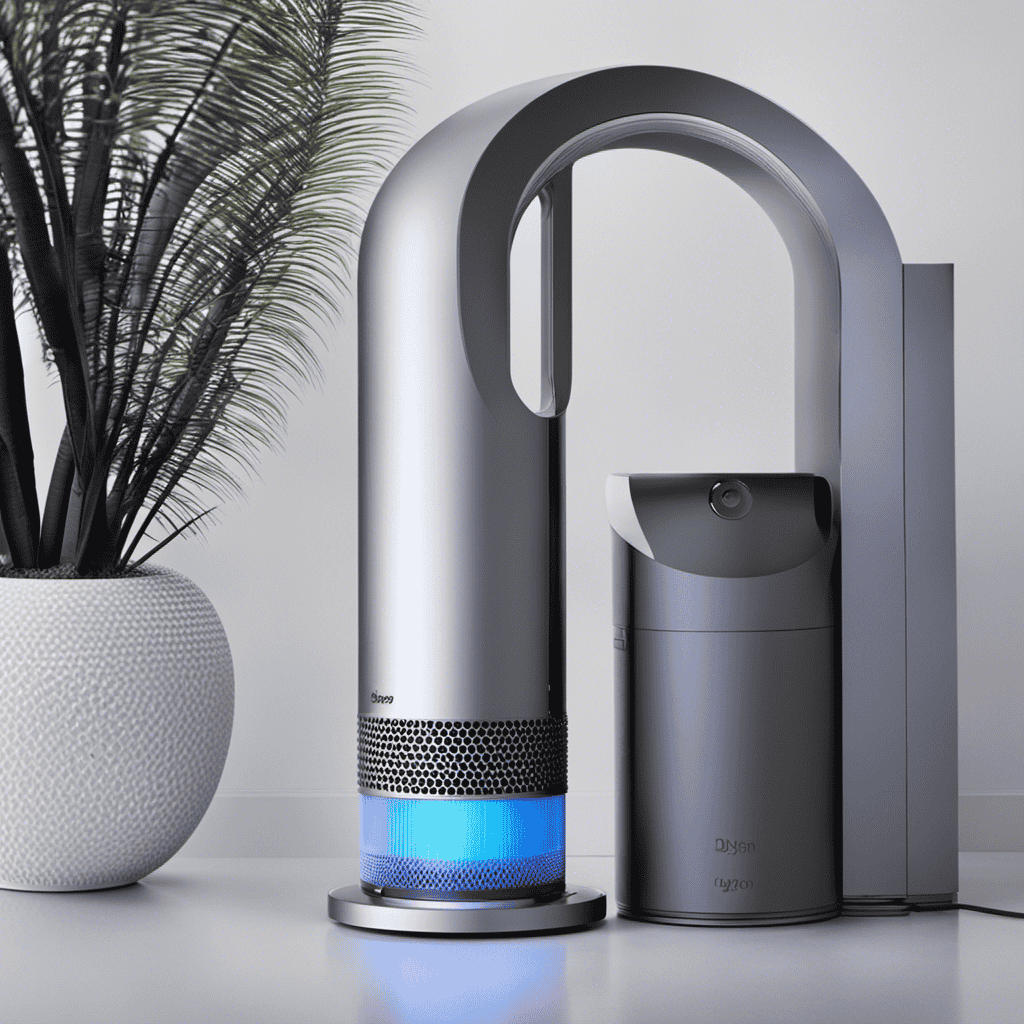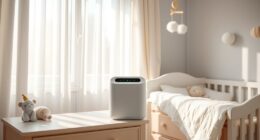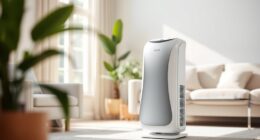Indoor air quality impacts your health through pollutants like mold, pet dander, VOCs, and smoke that can linger and cause allergies or respiratory issues. These contaminants come from sources like cooking, cleaning products, pets, and smoking. Air purifiers help by filtering out harmful particles and odors, improving the air you breathe. If you want to learn more about common pollutants and how to keep your indoor air clean, keep exploring these essential tips.
Key Takeaways
- Common indoor pollutants include mold, VOCs, pet dander, cooking fumes, and tobacco smoke, originating from various household sources.
- Indoor pollutants can cause respiratory issues, allergies, and long-term health risks like asthma and cardiovascular problems.
- Air purifiers with HEPA and activated carbon filters effectively remove allergens, odors, and chemical vapors from indoor air.
- Proper ventilation, regular filter maintenance, and cleaning help reduce pollutant levels and improve air quality.
- Implementing a combination of air purifiers and good habits is essential for maintaining healthy indoor air quality.
Common Indoor Air Pollutants
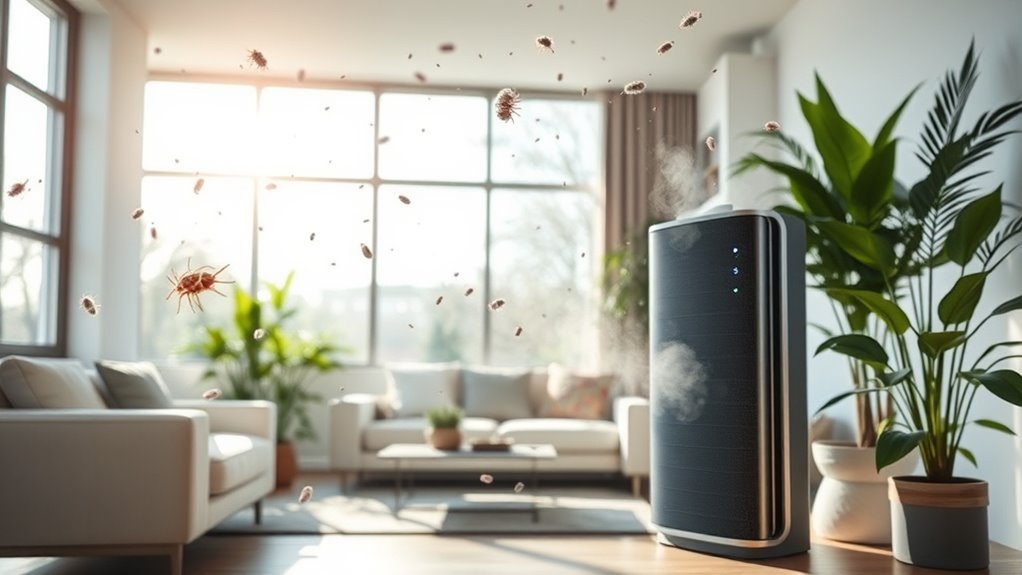
Have you ever wondered what pollutants might be lurking in the air inside your home? Indoor mold is a common culprit, thriving in damp areas and releasing spores that can cause allergies or respiratory issues. VOC emissions, or volatile organic compounds, come from everyday items like cleaning supplies, paints, and furniture. These chemicals vaporize into the air, often unnoticed, and can irritate your eyes, nose, and throat. Indoor mold and VOC emissions are significant contributors to poor air quality and can affect your health over time. Recognizing these pollutants is the first step toward improving your home’s environment. Proper ventilation, controlling moisture, and choosing low-emission products can help reduce your exposure to these indoor air pollutants. Understanding indoor pollutants is essential for creating a healthier living space. Additionally, AI-powered air quality monitors are becoming increasingly popular as they provide real-time data to help identify pollution levels and guide mitigation strategies. Awareness of air purification technologies can further enhance your ability to maintain a safer indoor environment, especially since many devices use HEPA filters to effectively trap airborne particles.
Sources of Indoor Contaminants
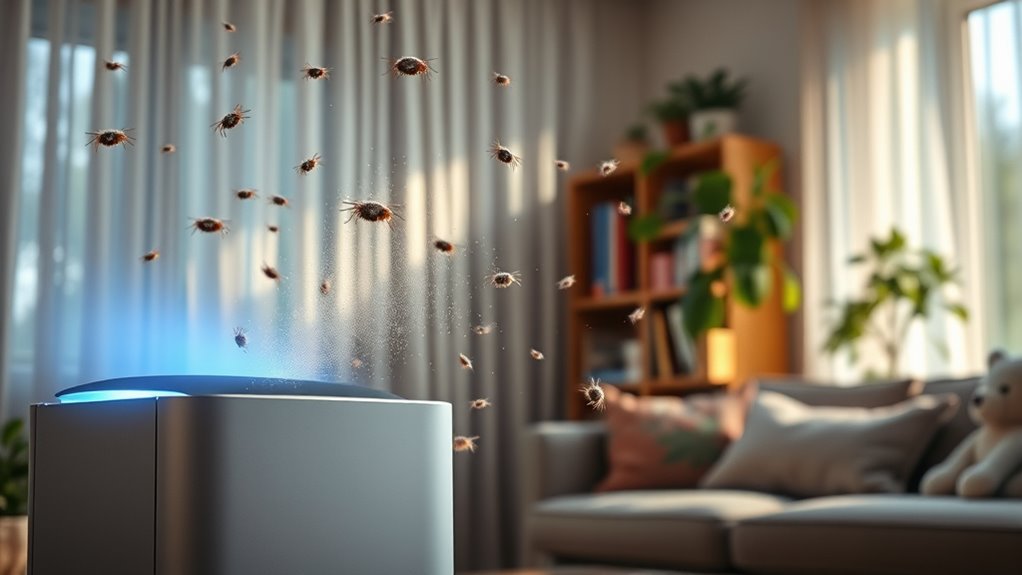
You might not realize it, but indoor smoking can considerably increase air pollutants in your home. Pet dander can also contribute to poor air quality, especially if you or family members have allergies. Additionally, cooking fumes from everyday meals release particles that can affect your indoor environment’s cleanliness and health. Implementing effective air purification methods can significantly reduce these pollutants and improve indoor air quality. Using air purifiers equipped with HEPA filters can help capture small particles like pet dander and cooking smoke, further enhancing the air you breathe indoors. Regular maintenance of air filtration systems ensures optimal performance and continued health benefits. Understanding the offensive security tactics used in ethical hacking can help you identify vulnerabilities before malicious actors do. Staying informed about indoor air quality trends and best practices can help you maintain a healthier living space.
Indoor Smoking Effects
Did you know that indoor smoking considerably worsens air quality by introducing a variety of harmful contaminants? When you smoke indoors, smoke residue settles on surfaces and lingers in the air, creating a persistent source of pollution. Secondhand smoke contains thousands of chemicals, many of which are toxic and carcinogenic. Even if you think you’re only exposing yourself, others nearby can breathe in these harmful substances, increasing health risks. Smoke residue can also react with indoor pollutants, forming new, dangerous compounds. This contamination can persist long after the smoking stops, making it harder to maintain good air quality. Using air purifiers with activated carbon or HEPA filters can help reduce these pollutants, but eliminating indoor smoking remains the most effective solution. Research indicates that pollutant levels can be significantly reduced with proper filtration and ventilation measures. Additionally, implementing ventilation techniques can further help disperse and dilute indoor contaminants, improving overall air quality. Proper ventilation and air exchange rates are crucial in maintaining a healthier indoor environment, especially in homes where smoking occurs. Incorporating air quality monitoring can provide real-time insights into pollutant levels, aiding better management of indoor air.
Pet Dander Presence
Pet dander is a common indoor contaminant that can substantially impact air quality, especially in homes with pets. These tiny skin flakes from animals become airborne and can trigger allergies. To reduce exposure, consider these sources:
- Pet fur and skin shedding, which release pet dander into the air.
- Pet bedding and furniture, where dander can accumulate over time.
- Carpets and rugs, acting as reservoirs for pet allergy triggers.
- Pet grooming tools, which can disperse dander if not cleaned regularly.
- Regular cleaning and air purification, especially with HEPA filters, can significantly lower pet dander levels indoors. Utilizing air purifiers with specialized filters is an effective way to trap airborne allergens and improve indoor air quality. Additionally, understanding the sources of indoor pollutants helps in implementing comprehensive strategies for a healthier home environment.
Understanding these sources helps you manage indoor air quality better. Using air purifiers with HEPA filters can effectively trap pet dander, reducing allergy triggers and creating a healthier environment for everyone.
Cooking Fumes Impact
Cooking fumes are a significant source of indoor air contaminants that can affect respiratory health and overall air quality. When you cook, especially at high temperatures, fumes release smoke, grease, and volatile organic compounds (VOCs) that can linger in your home. These cooking fumes impact air quality by adding pollutants that irritate your lungs and worsen allergies. Proper kitchen ventilation is essential to reduce these pollutants; using exhaust fans or range hoods helps remove fumes before they disperse throughout your space. Without effective ventilation, cooking fumes can accumulate, leading to increased indoor pollution levels. Innovative ventilation systems can further enhance your home’s air quality by efficiently removing airborne contaminants. Incorporating natural materials like wood and linen in your home can also help improve the overall air quality by reducing synthetic indoor pollutants. Regularly ventilating your kitchen minimizes health risks and improves air quality, making your indoor environment safer and more comfortable for you and your family. Recognizing the importance of indoor air quality and taking steps to improve it can significantly enhance your health and well-being.
Effects of Pollutants on Health
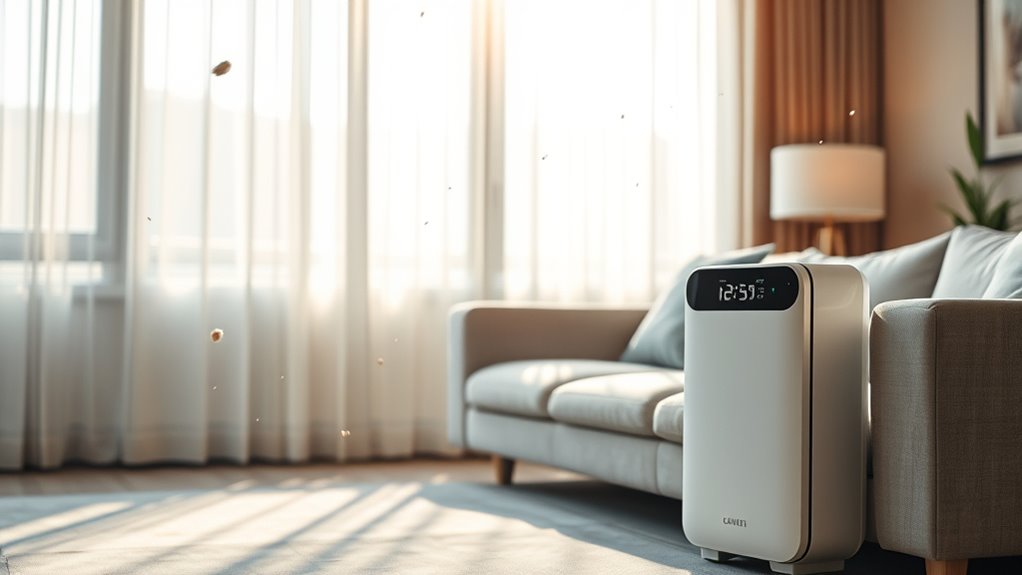
Pollutants in your indoor air can worsen respiratory problems and trigger allergies or asthma attacks. Over time, exposure may also increase your risk of serious health issues. Understanding these effects helps you take steps to protect your health indoors. Incorporating air purifiers can effectively reduce pollutants and improve air quality in your environment. Modern air purifiers with HEPA filtration are especially effective at capturing tiny particles such as dust, pollen, and pet dander, further safeguarding your health. Advances in AI-powered air quality monitoring are now helping homeowners better detect and manage indoor pollutants in real-time, which can be especially beneficial given the privacy and boundaries concerns related to smart devices. Additionally, awareness of Gold IRA investments underscores the importance of thorough research and avoiding scams to protect your assets.
Respiratory Problems Increase
When indoor air quality declines due to pollutants like dust, mold, and chemical fumes, your respiratory health can suffer markedly. Poor air quality can lead to increased respiratory problems, making breathing more difficult and uncomfortable. To combat this, effective indoor air filtration is essential. Here’s how pollutants impact you:
- Irritate your airways, causing coughing and wheezing.
- Aggravate existing respiratory conditions like COPD.
- Reduce lung function over time.
- Increase the need for respiratory therapy in severe cases.
- Understanding Rhythm Failure can help in choosing appropriate air purification solutions. Additionally, ongoing AI security measures are crucial to ensure that smart air quality devices operate safely and effectively without vulnerabilities that could compromise health data or device functionality. Recognizing the importance of data-driven strategies can further optimize the selection and maintenance of air purifiers for better health outcomes. Implementing advanced filtration technologies, such as HEPA filters, can significantly enhance the removal of airborne pollutants and improve overall air quality. Using sensor technology in air purifiers provides real-time feedback, helping to maintain optimal indoor air conditions.
Maintaining good air quality is key to supporting healthy breathing and minimizing respiratory issues.
Allergies and Asthma Flare
Have you noticed your allergies or asthma symptoms worsening even when you’re indoors? This happens because airborne allergens like dust mites, pet dander, and mold spores can trigger immune responses that worsen your condition. These pollutants irritate your airways, causing inflammation and tightening muscles, which lead to flare-ups. Poor indoor air quality means these allergens linger longer, increasing your exposure. When your immune system detects these particles, it reacts aggressively, releasing chemicals that cause symptoms like sneezing, coughing, and shortness of breath. Using air purifiers helps filter out airborne allergens, reducing your body’s immune response and alleviating symptoms. Keeping indoor air clean makes a significant difference in managing allergy and asthma flare-ups, helping you breathe easier and feel more comfortable at home.
Long-term Health Risks
Prolonged exposure to indoor air pollutants can pose serious long-term health risks, even if you don’t notice immediate symptoms. Indoor toxin accumulation from pollutants like dust, mold, and VOCs can gradually impact your health. With long-term pollutant exposure, you may face:
- Respiratory issues, including chronic bronchitis or COPD
- Increased risk of cardiovascular problems
- Development of allergies or worsening asthma
- Potential links to neurological conditions
These risks arise because pollutants build up over time, causing persistent inflammation and damage. Without proper air purification, indoor toxin accumulation worsens, raising your health risks. Protect yourself by understanding how long-term pollutant exposure affects your well-being and taking steps to improve your indoor air quality.
How Air Purifiers Work
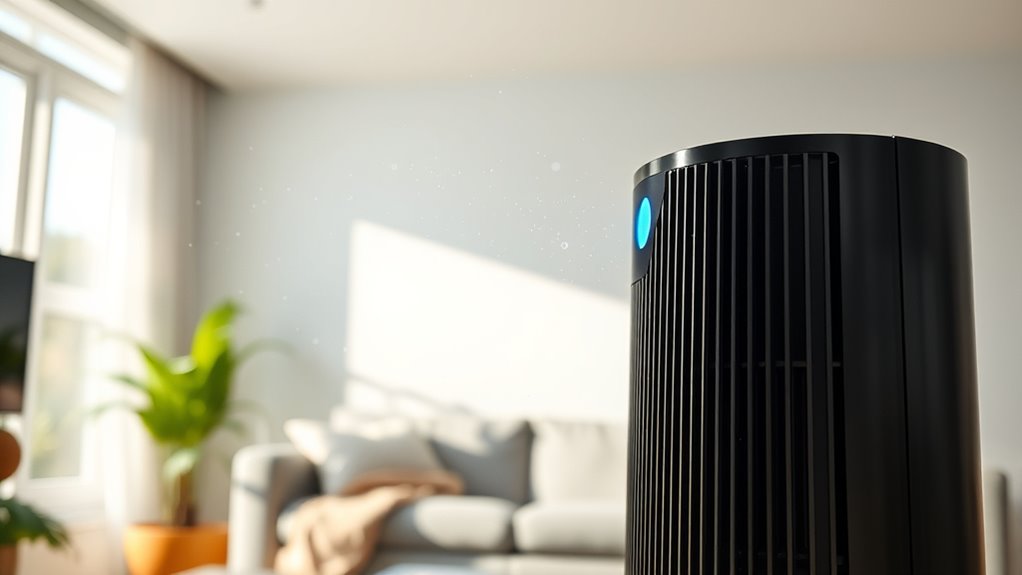
Air purifiers work by actively removing pollutants and allergens from indoor air, improving overall air quality. They achieve this through a filter mechanism that traps particles like dust, pollen, and pet dander. As the purifier operates, it pulls air into the unit, where the filter captures harmful particles, allowing cleaner air to flow back into your space. Effective air circulation is key, ensuring that contaminated air is continuously cycled through the filter. This constant movement helps eliminate pollutants quickly and prevents their buildup indoors. Depending on the device, different filters target specific pollutants, but the core process involves drawing in air, filtering out contaminants, and releasing purified air. This combination keeps your indoor environment healthier and more comfortable.
Types of Air Purification Technologies
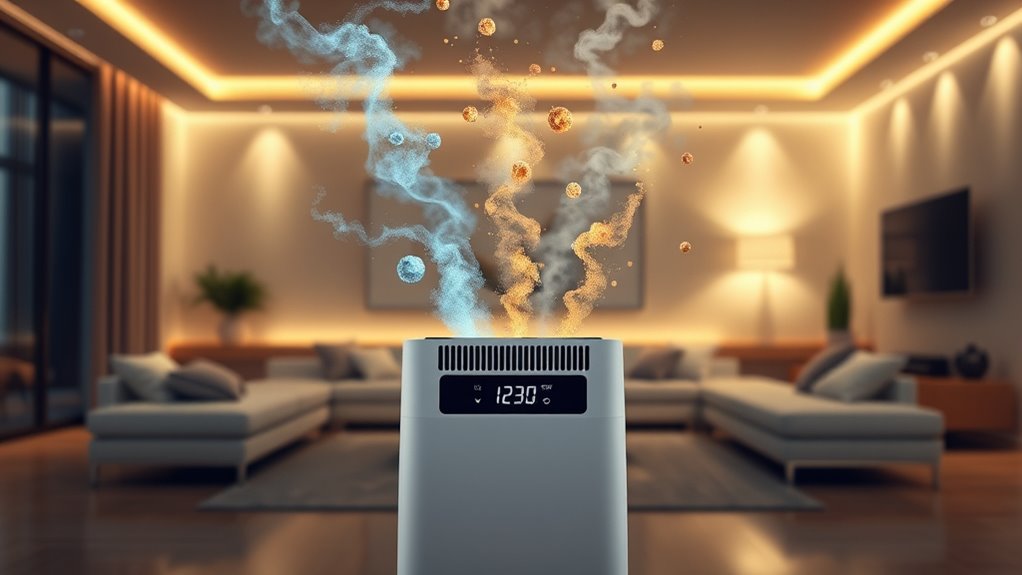
There are several effective types of air purification technologies designed to remove different pollutants from indoor environments. First, HEPA filtration captures particles like dust, pollen, and pet dander with high efficiency. Second, UV sterilization uses ultraviolet light to kill bacteria, viruses, and mold spores. Third, activated carbon filters absorb odors, volatile organic compounds (VOCs), and chemical fumes. Fourth, ionizers release charged particles that cling to pollutants, causing them to settle or be easily collected. Each technology targets specific pollutants, making them suitable for different needs. HEPA filters are excellent for allergens, UV sterilization for germs, activated carbon for smells, and ionizers for airborne particles. Combining these technologies can provide exhaustive indoor air purification.
Choosing the Right Air Purifier

Choosing the right air purifier depends on your specific indoor air quality concerns and the pollutants you want to address. Start by considering your room size; larger spaces need purifiers with higher Clean Air Delivery Rate (CADR) ratings to guarantee effective air cleaning. Pay attention to filter maintenance requirements—some filters need frequent replacements, which can affect long-term costs and convenience. For example, HEPA filters are excellent for dust and allergens, but they require regular upkeep. If you’re dealing with odors or chemicals, look for purifiers with activated carbon filters. Always choose a unit designed for the room size to maximize efficiency. By matching your needs with the right features, you’ll ensure cleaner air and better indoor air quality overall.
Tips for Maintaining Good Indoor Air Quality
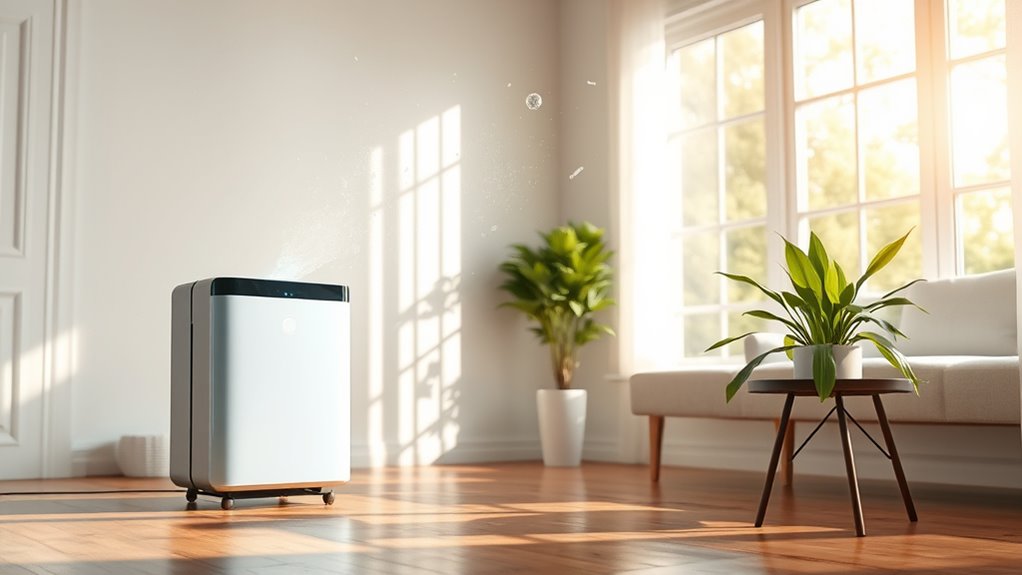
Maintaining good indoor air quality requires consistent effort and mindful habits. Start by using air quality sensors to monitor pollutants and adjust your environment accordingly. Here are four tips to help you stay on top:
- Regularly change or clean air purifier filters to guarantee maximum performance.
- Keep your space well-ventilated by opening windows or using exhaust fans.
- Incorporate indoor plants, which offer benefits like natural air filtration and humidity regulation.
- Avoid smoking indoors and limit the use of volatile organic compounds (VOCs) from cleaning products or paints.
Frequently Asked Questions
How Often Should I Replace or Clean My Air Purifier Filters?
You should follow the filter maintenance and replacement schedule recommended by your air purifier’s manufacturer. Typically, filters need cleaning or replacement every 3 to 6 months, but this varies with usage and air quality. Check the user manual for specific guidance. Regular maintenance guarantees your purifier works efficiently, improves indoor air quality, and prolongs its lifespan. Don’t wait too long—timely filter changes keep your air clean and healthy.
Are Air Purifiers Effective Against All Types of Indoor Pollutants?
You might wonder if air purifiers work against all indoor pollutants. The effectiveness depends on their filter types, like HEPA for allergens and VOC filters for chemicals. While they excel at removing many common pollutants, they won’t eliminate gases or odors completely. To maximize pollutant removal, choose a purifier with the right filter types for your specific indoor air concerns. Remember, no single purifier can cover every pollutant perfectly.
Can Air Purifiers Eliminate Odors From Pets or Cooking?
You might think air purifiers can wave away pet odors and cooking smells, but it’s not that simple. They do a good job at reducing these odors, especially with activated carbon filters designed for that purpose. However, they might not completely eliminate stubborn pet odor or intense cooking smells. To keep your home fresh, combine a purifier with good ventilation and regular cleaning—think of it as hitting two birds with one stone.
Do Air Purifiers Produce Ozone or Other Harmful Byproducts?
You might wonder if air purifiers produce ozone emission or harmful chemicals. Some models, especially those with ionizing or ozone-generating features, can release ozone or other harmful chemicals into your indoor air. To keep your environment safe, choose purifiers labeled as ozone-free and certified by reputable organizations. Always read the product details to guarantee it doesn’t emit ozone or harmful chemicals, helping you breathe cleaner, healthier air.
What’S the Best Placement for an Air Purifier in a Room?
Imagine your room as a vibrant space where clean air flows seamlessly. To optimize airflow, position your air purifier in a central spot away from walls and obstructions, ideally near the source of pollutants. This purifier placement guarantees maximum airflow optimization, allowing purified air to circulate efficiently throughout the room. Keep it elevated if possible, and avoid corners for effective purifier positioning, so you breathe easier in every corner.
Conclusion
So, after all this talk about pollutants and purifiers, it’s funny how something as simple as a filter can turn your indoor air from a hidden villain to a gust of fresh air. You’d think that fighting invisible foes would require high-tech gadgets, but sometimes, just a good purifier and a little awareness are enough to make your home healthier. Ironically, the best defense is often something you can buy at your local store.
